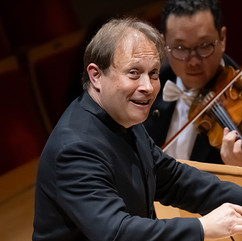Ludovic Morlot Takes His Chance at Pacific Symphony Podium
- Timothy Mangan

- Nov 17, 2023
- 3 min read
Updated: Nov 18, 2023
REVIEW: With an exceptional account of Debussy's La Mer, the conductor plays to his strengths.

The second guest conductor of the season trying out for the Pacific Symphony’s music directorship arrived Thursday night at Segerstrom Concert Hall. This one’s name preceded him; he’s probably the best known of the applicants.
Ludovic Morlot, 50 in a few weeks, is the conductor emeritus of the Seattle Symphony, current music director of the Barcelona Symphony and widely traveled as a guest conductor on the international circuit. He has recorded plentifully with the Seattle Symphony (much of it unusual and interesting repertoire) and is a multiple Grammy winner. He has an abiding interest in new music and a specialty in French (his nationality) music. The Pacific Symphony could do a lot worse.
Morlot brought along a program that displayed several of his interests, including two new pieces by California composers (the concert was part of the inaugural, statewide California Festival, and is scheduled to repeat Friday and Saturday), a seldom-encountered piano concerto, Rachmaninoff’s Fourth, which the orchestra was playing for the first time, and a masterpiece of the French repertoire, Debussy’s La Mer. In the event, it made for a satisfying agenda, put together by a man who says that programming keeps him up at night.
Morlot cuts a slight figure on the podium and his conducting manner is quite pedestrian, without theatrics. What he wants from the orchestra is clear, however, both from the force and precision of his gestures and from the expression on his open face (which we could see projected on the big screen above the orchestra).
The many faces of Ludovic Morlot while conducting the Pacific Symphony. Photos courtesy of Pacific Symphony/Doug Gifford
His La Mer was sharp and bracing. Not for Morlot a misty Impressionistic sea with gentle breezes. Tempos were fast and textures clear. You heard the urgency in Debussy’s music, the sting in his colors. Rhythms never lolled; a simple underpinning of trills in the strings became a rather nervous roiling under the waves. Climaxes would broaden, but he wouldn’t let them relax. This was a dangerous La Mer, never a postcard.
The orchestra was beautifully prepared in this demanding score as well, revealing a transparency in its sound not always encountered, virtuosity and energy.
Rachmaninoff’s Fourth Concerto is usually considered his least successful. Composed over many years, the composer struggled with it. The thematic material seems less than memorable; the formal argument meanders. And yet there is much to fascinate here, much to delight. Rachmaninoff was discovering new sounds in his orchestration, less gushing and more vivid. The musical ideas jump cut from one to another; you never know what’s coming or when. It all feels like a more modern Rachmaninoff.
Ukrainian pianist Vadym Kholodenko, the Van Cliburn winner in 2013, was the soloist and barely broke a sweat under the heavy demands of the part. Hardly flashy himself, he played most of it with his head down, but his fingers, hands, arms and body were loose, ready to engage with every swerve and acceleration in the music. His technique was clean and impeccable but never cold or precise. Rather it had a warm and easy feeling, reactive. Keep an eye out for this pianist.
Morlot and orchestra kept with him hand in glove, collaborated and never overwhelmed in this busy, frenetic orchestration.
Morlot opened the second half (before the Debussy) with Gabriella Smith’s dazzling Bioluminescence Chaconne. Inspired by an underwater dive off the Channel Islands, it made for a nice prelude to La Mer. Smith uses minimalistic techniques to create this 13-minute soundscape, but the chord progressions and rhythmic obsessions are somewhat out of phase throughout the orchestra, creating a swirling, shimmering, uncannily shifting effect. The work is most brightly colored as well, an etude in vibrancy.
Adam Schoenberg’s lovely but somewhat forgettable Canto began the concert, a sweetly lyric take on Ives, Copland and Debussy. It’s a perfectly accomplished work but, as with the first conductor audition, one felt like something more vigorous (a Berlioz overture, perhaps?) would have served more suitably as curtain raiser.

Classical music coverage at Culture OC is supported in part by a grant from the Rubin Institute for Music Criticism. Culture OC makes all editorial decisions.





























